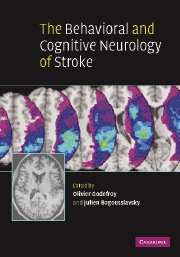Book contents
- Frontmatter
- Contents
- Contributors
- Preface
- 1 Evaluation of cognitive and behavioral disorders in the stroke unit
- Motor and gestural disorders
- Aphasia and arthric disorders
- Hemineglect, Anton–Babinski and right hemisphere syndromes
- Agnosia and Bálint's syndrome
- Executive and memory disorders
- Behavioral and mood disorders
- Dementia and anatomical left/right syndromes
- Index
- References
1 - Evaluation of cognitive and behavioral disorders in the stroke unit
Published online by Cambridge University Press: 10 October 2009
- Frontmatter
- Contents
- Contributors
- Preface
- 1 Evaluation of cognitive and behavioral disorders in the stroke unit
- Motor and gestural disorders
- Aphasia and arthric disorders
- Hemineglect, Anton–Babinski and right hemisphere syndromes
- Agnosia and Bálint's syndrome
- Executive and memory disorders
- Behavioral and mood disorders
- Dementia and anatomical left/right syndromes
- Index
- References
Summary
Introduction
The general aim of a clinical neuropsychological examination is to assess language, memory, attention, adaptive behavior, motivation, and emotion impairments that result from a brain dysfunction. This behavioral and cognitive evaluation can be performed during the first hours following cerebral damage either in a classical bedside approach or by means of standardized tests and may thus help establish a precise diagnostic. In the hyperacute or acute phase of stroke, neuropsychological intervention may also be necessary to establish communication with the patient (e.g. in the case of aphasia) or to set up adequate strategies to be used by healthcare providers (e.g. in the case of spatial neglect). In this context, the patient is most often tested while lying in bed and in the presence of other patients in the same room. Due to this context, as well as other disturbing factors, the evaluation of cognitive–behavioral deficits in the stroke unit is generally difficult, of relatively short duration, and must thus be repeated in order to correctly track the clinical evolution and to advise when the symptoms become more stable. Moreover, effective rehabilitation of cognitive deficits often relies on modular neuropsychological models (e.g. Pilgrim and Humphreys, 1994), which are often incompatible with clinical fluctuations and global dysfunction such as confusional states, frequently found in the acute phase. So, actual neuropsychological rehabilitation does not rely on acute evaluation.
In this chapter, we will first emphasize the difficulties in undertaking systematic neurocognitive evaluations in the stroke unit.
- Type
- Chapter
- Information
- The Behavioral and Cognitive Neurology of Stroke , pp. 1 - 14Publisher: Cambridge University PressPrint publication year: 2007

